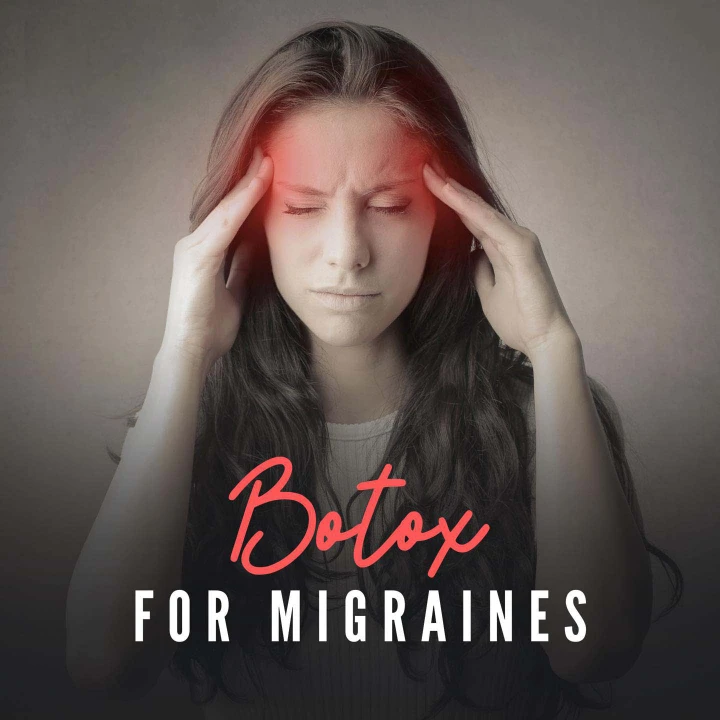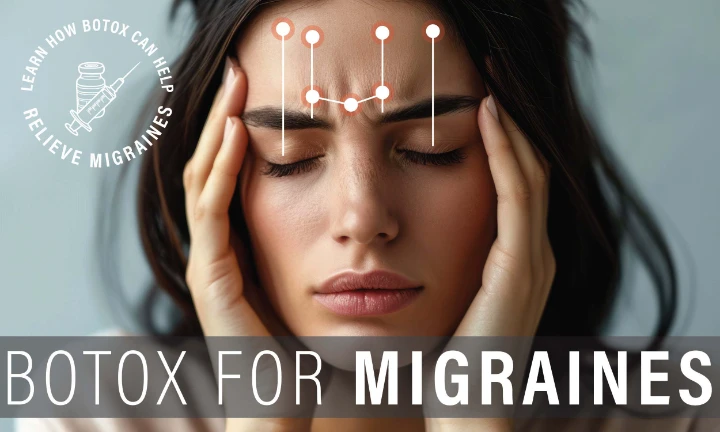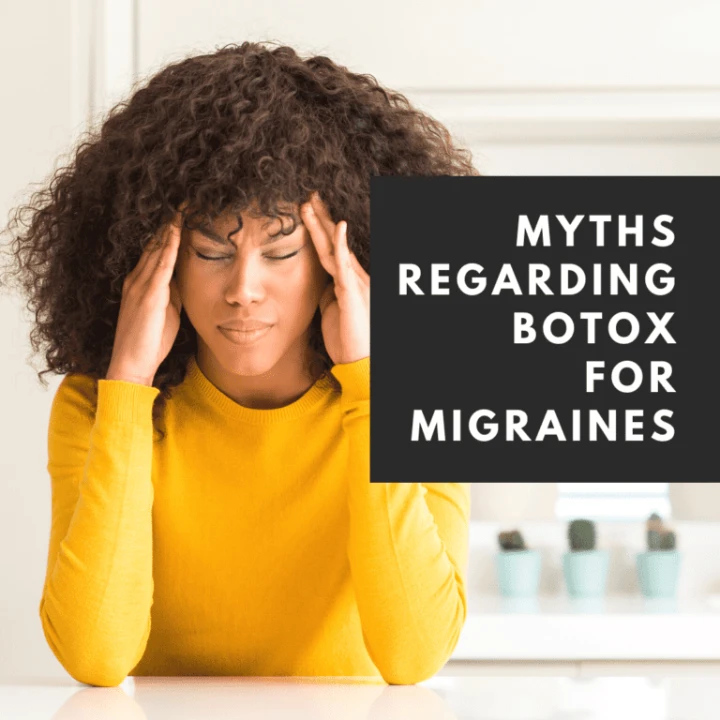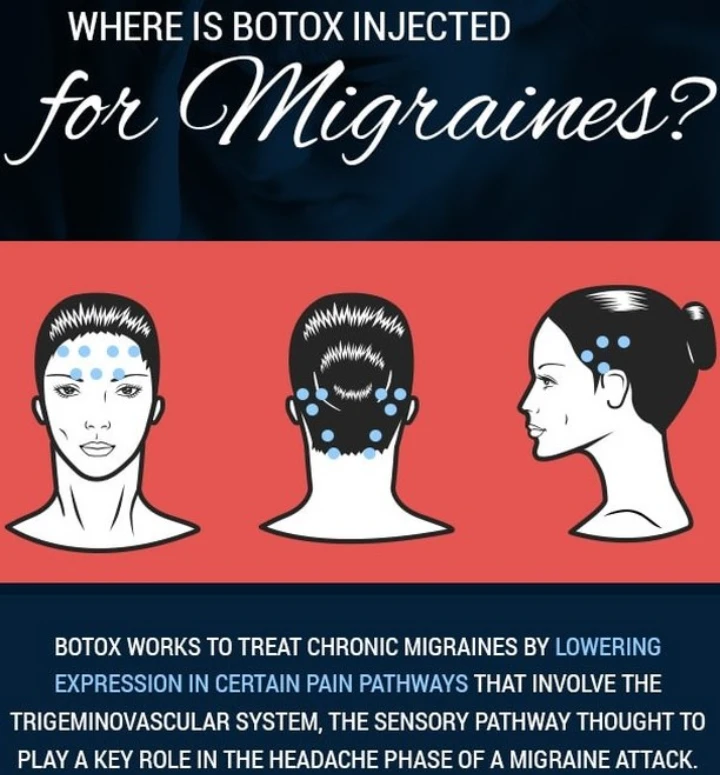Botox for Migraines Need To Know
Botox for Migraines are more than the average headache they are excruciating, ruin quality of life, and are downright crippling for some people. These types of severe headaches are usually accompanied by other symptoms, such as nausea, photophobia (sensitivity to light), phonophobia (sensitivity to sound), and even visual disturbances.
Although traditional treatments like medications and lifestyle changes are available, did you know that Botox are the most common treatment for chronic migraine? Originally associated purely with cosmetics, Botox is now FDA-approved to prevent chronic migraines.

Which means long-time sufferers of this severe, extremely frequent type of headache could find relief. In this article, we take an in-depth look at Botox for migraines, covering everything from how it works and its advantages to the possibility of side effects and what you can expect during treatment.
Botox for Migraines
What is Botox?
We are familiar with Botox (short for botulinum toxin) used in cosmetic medicine for decreasing wrinkles But also in medicine, it is used to treat hyperhidrosis, spasms, and those bad boys we all know so well MIGRAINES.
How Botox Treats Migraines
Downregulation of pain-signaling brain neurotransmitters is thought to lower the migraine rate with Botox. It essentially blocks your nerve pathways, preventing the chemicals from reaching the nerve endings in your head and neck.

Botox for Headaches
Is Botox Effective for Headaches?
However, for those with severe headaches that don’t quite fall into the chronic migraine provision, there are studies and testimonials showing positive use of Botox.
How Does it Compare to Other Treatments?
Common treatments for migraines include oral medications, lifestyle adjustments, and alternative treatments such as acupuncture. Botox is also a wonderful non-oral, noninvasive option for chronic migraines that can last up to three months.

Injections for Migraines
What to Expect During the Procedure
Botox injections for migraines are generally given every 12 weeks. This is done via several injections throughout your head and neck. The short version: Sessions consistently clock in at 15 -30 minutes, and can be carried out in a clinic.

Injection Sites
For those with migraines, there are FDA-approved injection sites for Botox treatment in migraines to give you directed comfort. These sites include:
- Forehead: Tension, Migraine preventative.
- Temples: For relief from pain and pressure in these prevailing migraine points.
- Back of the head: For occipital nerve pain and associated migraines.
- Neck: To help ease tension that can give you a headache.
- Upper back: To help ease tension that can give you a headache.

Botox for Migraines Side Effects

Common Side Effects
As with any medical treatment, Botox for migraines has side effects. These may include:
- Neck pain: Ranging from mild to painful enough to limit activities of daily living.
- Headaches: Ironically, so you may get a headache after you get treated Feeling of tightness in muscles, especially around the sites of injection with a possibility of restricted movement.
- Muscle stiffness: Particularly in the areas around the injection sites, potentially causing limited range of motion.
- Drooping eyelids: An effect when the upper eyelids begin to droop as a result of the muscle relaxant action of botulinum toxin. it is not a symptom or diagnosis, it has a temporary nature.
- Bruising at the injection site: Present in any injection but can range from mild to moderate and some people will find that it lasts for several days.
Serious Side Effects
While uncommon, you can have severe side effects you should consult with a doctor about these side effects:
- Difficulty swallowing or breathing: Symptoms of an allergic reaction or another serious condition.
- Muscle weakness: If develop weakness in a muscle or in muscles then it may be the result of serious problem in the body.
- Vision problems: A change in vision (i.e. blurry vision or blindness) should be followed up immediately to check for any serious complications.
What is Botox and How Does It Help with Migraines?
At this point, Botox, aka botulinum toxin, is most famous for its cosmetic usage to diminish the appearance of wrinkles. But, it has many more benefits beyond these cosmetics. For migraine headaches, Botox prevents the release of chemicals that cause pain signaling and keeps it from starting a migraine headache.
Botox for Migraines vs Botox for Headaches
While Botox works for chronic migraines, it is generally not used for other sorts such as tension headaches or cluster headaches. Migraines set themselves apart in the way they present as a chronic condition you have 15 or more headache days every month, with at least 8 being migraine days.
How is Botox Administered for Migraines?
Injection Sites for Migraine Relief
Botox migraine injections are commonly applied by a medical professional in a medical facility. Such injections are intended to decrease the frequency and intensity of migraines. The healthcare provider chooses specific sites around the head and neck where the injections are given depending on the patient’s particular symptoms and pattern of migraine headaches. Injection sites commonly:
- Forehead: The muscles of The Front of the Head, help with tension headaches.
- Temples: For the relief in the temples.
- Back of the head: Treats pain in the occipital area.
- Neck: To release the muscles that can heighten intensity of headache.
- Upper back: Donate to alleviate muscle stress that leads to migraines.
The Procedure
The process usually requires 31 injections in seven key regions. The entire procedure is completed within about 15-20 minutes, and there is rarely any downtime for activity.
What to Expect Post-Injection
Migraine Botox treatment may take two to three weeks to observe results in regard to reduced frequency and severity of migraine episodes. Nonetheless, for the majority of men it may be significant to undergo at least two to three treatments to reach the optimal potential of the reductions produced.
Potential Side Effects of Botox for Migraines
Although Botox is a safe choice for most, you should know everything you can regarding the side effects that are possible before proceeding with the procedure. Common side effects include:
- Neck Pain: It can cause pain in as early as a day after the injection.
- Muscle weakness: Including the site of the injection.
- Drooping eyelids: Sagging of the lids for weeks.
- Flu-like symptoms: Common flu symptoms like headache, and fever.
Less common side effects are more severe and require immediate medical assistance to prevent any lasting damage like difficulty swallowing or breathing. A detailed consultation would be beneficial for the patients with co-morbidities or those who are taking any other medication, to discuss the possible risks with your healthcare provider. So you have all the facts to determine whether Botox is a safer option to use or not.
Does Botox for Migraines Change Your Face?
This is one of the main worries of those who love beauty, that the application of Botox for migraines changes their characteristics-scroll down. The good news is that a much smaller amount is used for migraines, relative to the use of botox for cosmetic reasons. Therefore, it would not lead to or much of changes in appearance on the face.
Why Choose Botox over Other Migraine Treatments?
Long-lasting Relief
For headache sufferers with chronic migraine who often must take oral medications daily, Botox injections provide a more sustained treatment. Patients who experience this alleviation can be headache free for up to 12 weeks before needing to return for another treatment. This takes the daily load down on their memory to reduce any regimen fatigue or epigenetic potential for forgotten doses.
Minimal Side Effects
Botox has fewer side effects, making it a safer treatment than many other treatments for migraine. Most common side effects are mild and may include local soreness lasting for a few hours at the site of the needle, or small bruises. In reality, the likelihood that one will face severe side effects is minimal and Botox is a practical and viable option for those looking for a less invasive and easily manageable cure for their migraines.
Does Botox for Migraines Change Your Face?
Will Preventative Botox for Migraines Make Me Look Old? After all, it was cosmetic botox that made a name for botox in the first place. For migraines, however, the intent is to inject into certain muscles associated with pain responsible for headaches, not aesthetics.
Generally, the injections are given into places such as the forehead, the temples, the back of the head, the neck, and the shoulders. Although you may observe some slight adjustments to these regions, they are less really visible than when Botox is done exclusively for visual reasons.
Where is Botox Injected for Migraines?
The seven areas where Botox is injected during migraine treatment blocks the pain pathways used in response to feeling a headache. These areas include:
- Forehead – Injections to this area can relax muscles that cause tension headaches.
- Temples – Focusing on this club can also help calm down the throbbingness of headaches that emanate from the side of head.
- Bridge of the nose – Nasal bones As mentioned earlier, at this site, sinus-related migraine symptoms can be treated.
- Back of the head – Where many of the muscles responsible for chronic tension headache (and migraines) attach.
- Neck – Reducing the stress and tension in the muscles of the neck might relieve pressure that contributes to migraines.
- Upper back – This area can be used to manage muscle tension that causes or might worsen migraine attacks.
- Shoulders – Reduced muscle tightness or tension in this area may lead to improved posture, and indirectly impact migraine severity.
There are 31 injections that doctors can deliver at these sites to comprehensively attack the pain pathways that are involved in chronic migraines. Such a protocol of treatment, in the form of the PREEMPT system (Phase 3 REsearch Evaluating Migraine Prophylaxis Therapy), is designed to generate maximal benefit in the reduction of the frequency and intensity of migraine episodes. This has been demonstrated empirically in studies and clinical trials to provide vast relief and help improve the quality of life for many chronic migraine sufferers.
How to Get Botox for Migraines Covered by Insurance
Botox treatment for migraines is expensive, but many insurance plans cover it. How to Improve Your Odds of Getting Treatment Covered:
- Diagnosis:
Documented diagnosis of chronic migraines by a neurologist or headache specialist. According to the International Classification of Headache Disorders, chronic migraines are characterized by 15 or more headache days per month, with at least eight of those headache days being migraines and lasting longer than three months.
- Documentation:
By your detailed headache diary. Well, duh, right ???? But seriously, keep track of every headache/migraine, how long it lasted, and how intense it was. Your doctor will need this information to create a compelling argument Botox treatment.
- Previous Treatments:
Implement all the other treatments that you have previously tried and document the effects of. Most insurance companies will make you attempt and fail at least two other treatments before they will approve Botox.
- Pre-authorization:
Work with your physician to put in a pre-authorization request with your insurance. This request should have your diagnosis, a headache diary, and your past treatment history.
- Persistence:
If the first request is denied, do not be disheartened. Insurance companies frequently reverse their refusal if an appeal is lodged or additional documentation is provided.
Does Botox for Migraines Help Wrinkles?
Botox for Migraines: It Also Helps You Look Better While Botox is designed to target headache symptoms, it also has some potential cosmetic perks. Because some of the areas that are injected overlap with the cosmetic areas (ie the forehead & around the eyes), one of the first things that you notice is that the stretching effect from fewer wrinkles yet remains. But these injections are actually designed to help the pain of migraines go away, so any cosmetic changes that occur are secondary to this.
Conclusion
Botox is an effective weapon in the magic war against chronic 1 migraines. From fewer headaches to perhaps some cosmetic benefits, it is not surprising that people are seeking this treatment out in growing numbers. If you are not sure, you should talk with a doctor who specializes in migraine management.
1 thought on “Botox For Migraines Complete Powerful Guide in 2024”